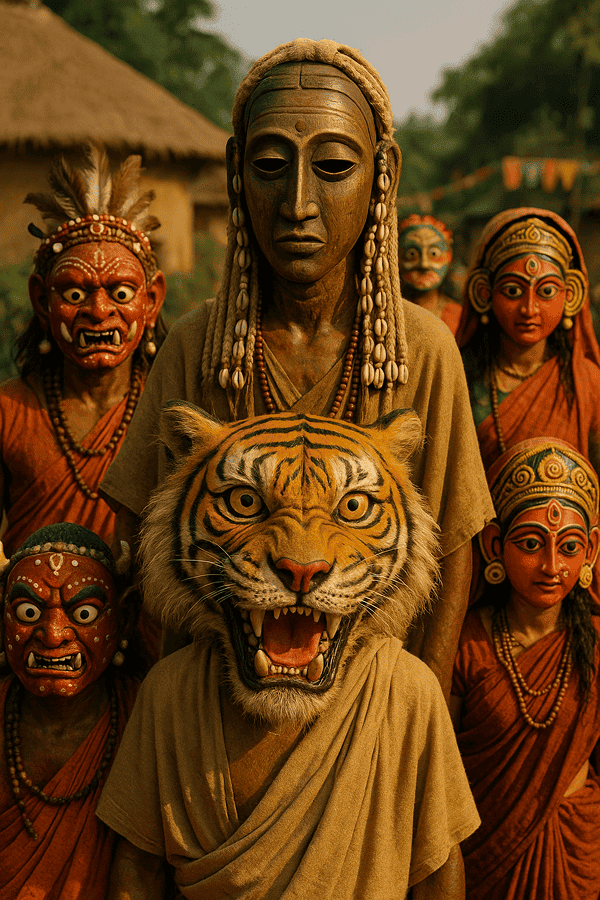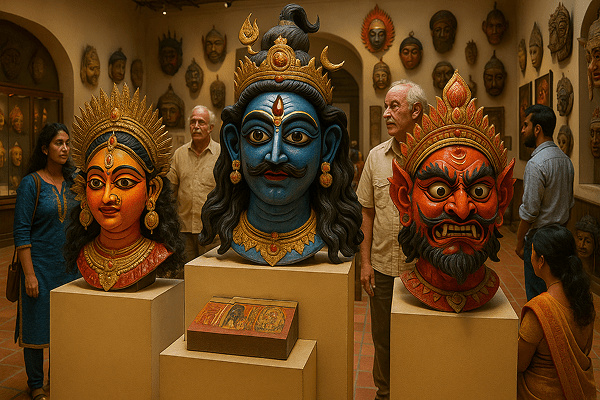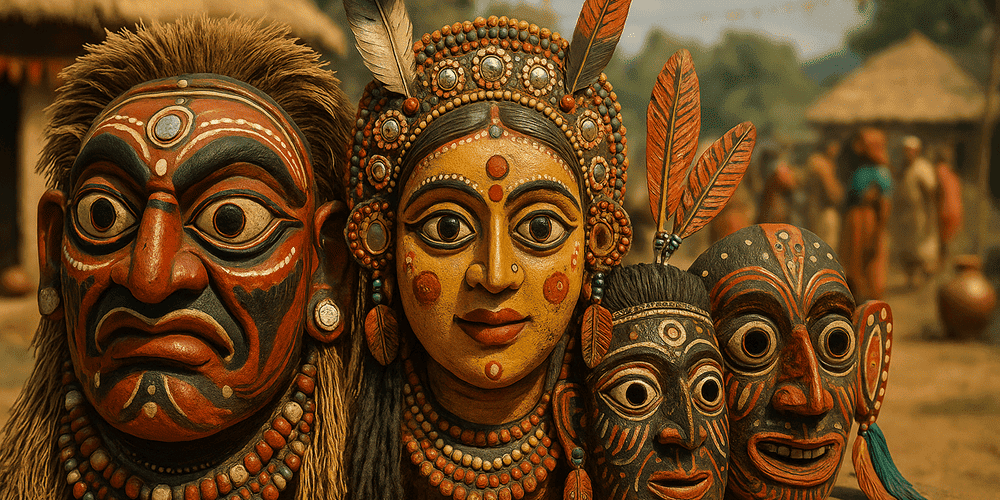Tribal Masks from India are extraordinary artifacts that reflect the spiritual, social, and artistic life of the country’s diverse indigenous communities. These masks are most often recognized for their striking and bold features — prominent eyes, dramatic noses, exaggerated mouths, and vibrant colors such as red, black, white, and ochre. They are often adorned with natural materials like feathers, beads, shells, mirrors, and fiber, contributing to their powerful visual impact. Indian Tribal Masks are created and used by various tribes across regions such as West Bengal, Odisha, Jharkhand, Gujarat, Chhattisgarh, Assam, and the North-East, each with its own distinct style and tradition. Their origins are ancient, with some traditions dating back thousands of years, closely linked to indigenous festivals, rituals, harvest celebrations, and ancestral worship.
Historical Origin of Indian Tribal Masks
The history of Indian Tribal Masks is deeply rooted in the country’s prehistoric animistic beliefs and the ritual practices of its tribal societies. The term “mask” in several tribal languages—such as “Mukha” (Bengali), “Mukhosh” (Assamese), or “Chhau Mukha” — simply means “face” or “disguise,” denoting both transformation and protection. Masks likely originated as a means to connect with nature spirits, ward off malevolent forces, and enact mythological stories. Archaeological finds in rock shelters and ancient village sites show evidence of mask use in ritual and ceremonial contexts dating back to early human settlements. Over time, the design and function of masks evolved, shaped by tribal migration, religious influences, and cultural exchange. During the medieval era, as Hinduism and local forms of worship intertwined, tribal masks began to reflect stories from epics like the Ramayana and Mahabharata, as well as local myths. Notable historical references include the use of masks in the Chhau dance of Purulia and Seraikela, and in the ritual performances of the Bhil, Gond, and Garoda tribes. The evolution of Krishna Masks in certain regions demonstrates the blending of tribal and mainstream Hindu traditions.
Cultural Significance and Symbolism of Tribal Masks in India
The symbolic meaning of Tribal Masks in Indian culture is profound and layered. Masks are considered sacred, believed to be inhabited by deities, spirits, or ancestors during rituals. They enable the wearer to transcend ordinary identity and become a vessel for supernatural power, whether in the context of exorcism, harvest festivals, or fertility rites. Many masks represent gods, demons, animals, or legendary heroes, each with its own cultural narratives and ritual significance. For instance, tiger and animal masks are used to invoke strength and protection, while ancestor masks connect communities with their lineage. Myths abound, such as the origin stories of Chhau masks believed to be inspired by visions received during meditation. Socially, masks play a crucial role in maintaining communal harmony, teaching moral lessons, and transmitting oral traditions. Their use in festivals and dances fosters unity, continuity, and a sense of belonging among tribal members.

Materials and Craft Techniques of Indian Tribal Masks
Indian Tribal Masks are traditionally made from locally available materials, combining functionality, symbolism, and artistic expression. The most common materials include lightweight woods (such as neem, mango, or kadamba), clay, bamboo, paper-mâché, and at times metal or leather. The crafting process often starts with selecting and ritually purifying the raw material. Artisans use chisels, knives, and carving tools to shape the mask, followed by smoothing, hollowing, and detailing. Once the form is complete, masks are painted with natural pigments — bright reds, blacks, yellows, and whites — often derived from minerals or plants. Decorative elements like feathers, beads, animal hair, shells, and mirrors enhance the mask’s appearance and spiritual potency. Each community has its own signature techniques: Chhau masks from West Bengal are renowned for their paper-mâché layering and bold, sculpted features, while the Galo and Mising tribes of Assam favor bamboo and cane. Color symbolism is crucial — red for energy or war, black for power or death, white for purity or spirits, and yellow for prosperity or the divine.
Functions and Uses of Tribal Masks in India
The primary function of Tribal Masks in India is ritual and ceremonial. They are worn during key life-cycle events, festivals, exorcism rites, and agricultural celebrations. Chhau masks, for example, are central to the Chhau dance, a vibrant martial dance drama depicting mythological battles. In Gujarat’s Garoda tribe, masks are used in Bhavai performances — folk theater with religious themes. Masks serve theatrical purposes, allowing performers to embody gods, demons, animals, or ancestors and to enact stories from folklore or epic literature. During festivals, processions, and public celebrations, masks energize the atmosphere, entertain crowds, and reinforce cultural identity. Over time, the function of masks has expanded; today, they are used in educational programs, museum displays, and even as symbols in contemporary art and activism, adapting to new cultural contexts while preserving their ritual essence.
Regional Variations of Indian Tribal Masks
India’s vast geography and cultural diversity have given rise to a wide range of regional mask traditions. In eastern India, the Chhau masks of Purulia (West Bengal), Seraikela (Jharkhand), and Mayurbhanj (Odisha) are characterized by their robust features, intricate ornamentation, and connection to epic narratives. Northeastern tribes like the Galo, Mising, and Nyishi of Arunachal Pradesh and Assam produce masks with animal motifs and natural materials, reflecting their animistic worldviews. In central India, the Bhil and Gond tribes craft masks for ancestor worship and hunting rituals, often with earthy colors and geometric designs. The Garoda and Dang tribes of Gujarat use masks in their unique Bhavai folk theater. Local styles are shaped by environment, available materials, and historical contact with neighboring cultures. Compared to African or Southeast Asian tribal masks, Indian masks are notable for their narrative richness and integration with dance and theater.
Famous Examples and Collections of Indian Tribal Masks
Some of the most famous Indian Tribal Masks are associated with the Chhau dance, recognized by UNESCO as Intangible Cultural Heritage. Iconic Chhau masks — depicting gods like Shiva, Durga, and Ravana — are displayed at the Chhau Mask Museum in Charida (West Bengal). The National Museum in New Delhi and the Indian Museum in Kolkata house significant collections of tribal masks from across the country. Other notable collections can be found at the Indira Gandhi Rashtriya Manav Sangrahalaya (Bhopal), the Tribal Museum (Bhubaneswar), and in private galleries. Archaeological finds of ancient wooden and clay masks provide evidence of their antiquity. Internationally, Indian tribal masks feature in exhibitions at major ethnographic museums and are highlighted in virtual galleries such as toddmasks.com, making them accessible to global audiences.

Influence of Indian Tribal Masks on Art and Culture
The influence of Tribal Masks on Indian art and culture is profound. Their striking forms, vibrant colors, and mythological themes have inspired generations of painters, sculptors, and contemporary artists. Masks are referenced in literature, film, and music, where they symbolize transformation, hidden identity, or spiritual power. Modern designers incorporate mask motifs into textiles, jewelry, and home décor, blending traditional aesthetics with contemporary trends. The presence of masks in cultural festivals and public art projects helps sustain awareness and appreciation of indigenous heritage. By preserving and reinterpreting mask traditions, Indian society affirms the value of its tribal cultures and their contributions to national identity.
Modern Status and Preservation of Indian Tribal Mask Traditions
Today, the tradition of Tribal Masks in India is at a crossroads, facing both challenges and revitalization. Many master artisans continue to create masks using ancestral techniques, often passing their skills to younger generations within the community. NGOs, government agencies, and cultural organizations support mask-making through workshops, festivals, and market initiatives. Innovations include the use of new materials, digital media, and collaborative art projects. Museums and online resources — such as toddmasks.com — play a key role in documenting, teaching, and promoting mask culture. Educational programs and masterclasses help sustain interest and ensure the survival of these ancient arts. Contemporary artists and performers are also adapting mask traditions to address modern themes and social issues, proving their ongoing relevance.
Collecting and Acquiring Indian Tribal Masks
The market for Indian Tribal Masks is varied, with authentic masks available through artisan cooperatives, government emporiums, galleries, and specialized online platforms. Prices depend on age, craftsmanship, condition, and provenance. Collectors are advised to seek expert authentication, verify the origins of masks, and prioritize ethical sources that benefit tribal artists and communities. High-quality replicas and contemporary interpretations are also valued by collectors and educators. Toddmasks.com offers guidance on recognizing authenticity, understanding the cultural context, and supporting responsible collecting. Ethical considerations include respecting the sacred origins of masks and avoiding the exploitation of living traditions.
